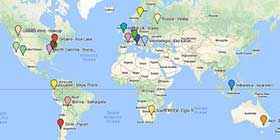
Photo by Markus Spiske on Unsplash
Introduction
The sun, a constant source of energy, is often underestimated in terms of the incredible potential it holds. Solar panels, which harness this power, have evolved from a niche technology to a key player in revolutionizing the way we live. From rooftops to roads, solar energy is making its way into every corner of our world, offering innovative solutions that go beyond just generating electricity for homes. Let’s take a journey through the many facets of how solar panels are transforming industries, enhancing sustainability, and paving the way for a cleaner, greener future.
Solar Panels: A Quick Overview
Before diving into their widespread impact, it's important to understand what solar panels are and how they work. Solar panels, also known as photovoltaic (PV) panels, convert sunlight into electricity through the photovoltaic effect. Each panel is made up of silicon cells that capture sunlight and convert it into usable energy. This process generates electricity without the need for harmful emissions or fossil fuels, making it an eco-friendly energy source.
The most common use of solar panels is in household solar systems, where they are installed on residential rooftops to reduce electricity costs, improve energy independence, and lower carbon footprints. However, this is only the beginning of solar’s potential. The applications of solar energy extend far beyond residential homes, with industries and even infrastructure embracing solar solutions in new and exciting ways.
Household Solar: Powering the Future of Homes
At the heart of the solar revolution is the household solar system. As more homeowners recognize the long-term benefits of switching to solar, the adoption rate of residential solar panels has skyrocketed. Solar panels on rooftops have become a familiar sight across suburban neighborhoods and urban centers alike, providing power for everyday appliances, lighting, and heating.
The financial advantages of household solar are compelling. With electricity prices rising globally, installing solar panels offers homeowners the opportunity to drastically cut energy bills by producing their electricity. Moreover, advances in battery storage technology, such as the Tesla Powerwall, allow homeowners to store excess energy produced during the day for use at night or during cloudy days. This creates a level of energy independence that was once thought impossible.
In some cases, household solar systems can even generate excess energy that is fed back into the grid, potentially earning homeowners credits or payments from local utilities. As governments around the world push for cleaner energy solutions, tax credits, rebates, and incentives are making solar more affordable for homeowners than ever before.
Solar-Powered Vehicles: A Road to a Sustainable Future
When you think of solar panels, cars may not be the first thing that comes to mind. However, solar-powered vehicles are becoming an increasingly significant part of the transportation sector. Imagine driving down the highway in a car that not only consumes no gasoline but also generates its own power through solar energy.
Solar panels are now being integrated into vehicles, from electric cars to buses, trucks, and even airplanes. Companies like Lightyear and Aptera have created solar-powered electric cars that use rooftop solar panels to charge the vehicle's battery, significantly extending its range without needing to plug into the grid. While these solar vehicles are still in the early stages of development, their potential to reduce reliance on traditional charging infrastructure and fossil fuels is undeniable.
On a larger scale, solar energy is also being utilized in public transportation systems. In regions where mass transit is prevalent, buses and trains powered by solar energy are becoming more common, providing cleaner alternatives to diesel-powered options.
Solar Roads: A Glimpse Into the Future of Infrastructure
Perhaps one of the most futuristic applications of solar technology is in the form of solar roads. Imagine driving on a road that generates electricity as you travel, lighting street lamps, powering signs, and even providing energy to local infrastructure—all from the same surface. This is the concept behind solar roadways, a groundbreaking innovation that has the potential to revolutionize the way we think about infrastructure.
Solar roads are essentially highways or streets with embedded solar panels that capture sunlight and convert it into electricity. These panels are built to withstand heavy traffic, extreme weather conditions, and the everyday wear and tear that roads endure. The electricity generated by solar roads can be used to power nearby buildings, streetlights, or electric vehicles passing by. In some cases, these roads could even be used to power electric vehicle charging stations, creating a self-sustaining transportation network.
While solar roads are still in the experimental phase, pilot projects are underway in several countries. For example, France has installed solar panels on a section of its highway, known as Wattway, to test the feasibility of solar-powered roads. If successful, this could lead to the widespread adoption of solar roadways, reducing our reliance on traditional power grids and creating a more sustainable infrastructure.
Solar in Agriculture: Powering the Fields
In addition to residential and transportation uses, solar energy is also making waves in agriculture. Farmers around the world are integrating solar panels into their operations to reduce energy costs, improve efficiency, and increase sustainability. Solar-powered irrigation systems, for example, are helping to address water scarcity in drought-prone areas by providing an off-grid solution for water pumping.
Solar panels are also being used to power greenhouses, cold storage facilities, and even livestock operations. In regions where electricity access is limited or unreliable, solar energy offers a reliable alternative that ensures that agricultural operations run smoothly without relying on fossil fuels. This transition not only helps farmers reduce their carbon footprints but also increases the economic viability of rural and remote communities.
In some innovative cases, solar farms are being integrated into agricultural fields, providing a dual-purpose solution where land is used for both food production and clean energy generation. These “agrivoltaics” systems combine solar energy production with farming, making better use of available land while reducing environmental impact.

Solar-Powered Buildings: The Rise of Green Architecture
Solar panels are also transforming the architecture and construction industries. In addition to residential homes, commercial buildings, schools, and even hospitals are now incorporating solar panels into their designs. The goal is not just to reduce energy consumption but to create buildings that are self-sustaining and energy-positive.
Building-integrated photovoltaics (BIPV) is one of the most exciting developments in this field. BIPV involves integrating solar panels directly into building materials, such as windows, facades, and rooftops. This technology enables architects to design aesthetically pleasing buildings that seamlessly incorporate solar energy systems without compromising on style or functionality.
The Global Shift Toward Solar Energy
The global shift toward solar energy is gaining momentum, driven by the need for cleaner, more sustainable sources of power. Countries around the world are embracing solar technology as a way to reduce their reliance on fossil fuels, mitigate the effects of climate change, and transition to greener energy systems.
For instance, in countries like India, China, and the United States, solar farms are being developed at an unprecedented rate. These large-scale solar projects are helping to power entire communities and industries, providing a renewable source of energy that reduces carbon emissions and promotes sustainable growth.
International initiatives, such as the Paris Agreement, are also pushing nations to adopt renewable energy solutions, including solar power, to meet their climate goals. As governments introduce policies, incentives, and subsidies to promote solar energy adoption, the cost of solar technology continues to drop, making it more accessible to individuals, businesses, and communities worldwide.
Challenges and the Road Ahead
While the impact of solar panels on our world is nothing short of revolutionary, there are still challenges to overcome. One of the biggest hurdles is the intermittent nature of solar energy. Solar panels only generate power when the sun is shining, which means energy storage solutions are essential to ensure a consistent supply of power. Fortunately, advancements in battery technology are making it easier to store excess energy for use when needed, but there is still room for improvement.
Additionally, the widespread adoption of solar energy requires significant infrastructure investments, particularly in grid integration and storage systems. Governments, businesses, and consumers must continue to collaborate and invest in the technologies needed to support the transition to a solar-powered future.
Conclusion: Solar’s Bright Future
Solar panels are no longer just a trend—they are a key component of a global movement toward a cleaner, more sustainable future. From household solar systems powering homes to solar roads and vehicles transforming transportation, the potential of solar energy is limitless. As technology continues to evolve and the world embraces renewable energy, solar panels will undoubtedly play an even more significant role in shaping every corner of our world. The journey to a solar-powered future has just begun, and with it comes the promise of a cleaner, greener, and more energy-efficient world for generations to come.

















